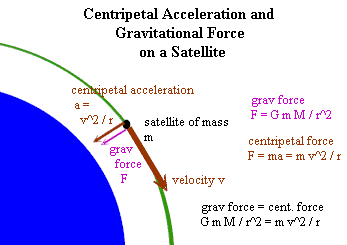
Problem: An object of mass 860 kilograms is orbiting a planet of mass 5 *10^ 26 kilograms at a radius of 2.000 * 10 ^ 4 kilometers. What is the acceleration of the mass toward the center of the planet? How fast must be object be traveling if it is to remain in a circular orbit about the planet? How long will it take the object to complete one orbit? Neglect any difference between the radius of the orbit and the distance between the object and the center of the planet.
.
.
.
.
.
.
.
.
.
.
.
.
.
.
.
.
.
.
.
.
.
.
.
.
.
.
.
.
.
.
Solution: The gravitational force is obtained by substituting the masses of the planet and the object, and the distance ( 2.000 * 10 ^ 4 km)(1000 m/km) = 2.000 * 10 ^ 6 meters for m1, m2 and r in the expression F = G m1 m2 / r ^ 2. We obtain a gravitational force of
gravitational force = 7.170 * 10 ^ 5 Newtons.
Dividing this by the mass 860 kilograms of the object we obtain the acceleration of the object due to gravity. This acceleration is
gravitational acceleration = ( 7.170 * 10 ^ 5 Newtons)/ kg = 833.7 meters/second ^ 2.
In order to remain in a circular orbit at this distance, the object requires a velocity v such that its its precise centripetal acceleration v ^ 2 / r, no more and no less, is supplied by the gravitational field. We know that r is the radius 2.000 * 10 ^ 6 meters of the orbit. Thus v ^ 2 / r = v^2 / 2.000 * 10 ^ 6 meters = 833.7 meters/second ^ 2. Solving for v, we obtain
v = 1.291 * 10 ^ 4 meters/second ^ 2.
The distance traveled in one orbit is the circumference of the circular path whose radius is r = 2.000 * 10 ^ 6 meters. This circumference is therefore 2 `pi ( 2.000 * 10 ^ 6 meters) = 1.256 * 10 ^ 6 meters. At 2.000 * 10 ^ 6 m/s the time required for an orbit is therefore
`T = `ds / v = 1.256 * 10 ^ 6 meters/ 7.170 * 10 ^ 5 meters/second = 97.28 seconds.
Note that the planet and the object in fact orbit their common center of mass. However, since the object is much less massive than the planet, the center of mass is essentially the same as the center of the planet. This assumes that the planet is spherical and that its mass is distributed symmetrically about its center. These assumptions would be appropriate to a communications satellite orbiting the Earth, but would not be completely accurate for the Moon (the center of mass of the Earth-Moon system is located at a point near the surface of the Earth, not at its center). Nor would they be particularly good for a spacecraft orbiting the Moon, since the Moon is denser on the side facing the Earth and is therefore not spherically symmetric.
Generalized Response: This problem illustrates the general principle used in calculating the periodand velocity of a circular orbit. The general principle is that thecentripetal force holding the object in its circular path is provided bythe gravitational force on the object.
If we let v, r, m and M stand for the velocity of the object, the radius of the orbit (from the center of the planet to the small satellite), the mass of the satellite and the mass of the planet, respectively, we see that the centripetal forcem v ^ 2 / r on the object, whose mass is m, is equal to the gravitationalforce G m M / r ^ 2 between the object and the planet, whose mass is M.The equality between centripetal forceand gravitational force is expressed in the equation
condition for circular orbit: m v ^ 2/r = G m M / r ^ 2.
This equation can be simplified by dividing both sides by m, which yields
condition for circular orbit, m omitted: v ^ 2 / r = G M / r ^ 2.
The left-hand side is just the centripetal accelerationof an object moving with velocity v in a circle of radius r, and the right-hand side is the gravitational field strength, in m/s ^ 2, at distance r from the center of theplanet. This form of the equation shows that the speed of anobject orbiting a planet is independent of the mass of the object.
Thisequation could be solved for v to obtain v = `sqrt(G M / r), or it could besolved for r to obtain r = G M / v ^ 2.
In the current problem we need to find v, so we solvethe original equation for v and substitute the mass M ofthe planet and the radius r of the orbit.
To find the period T of the orbit (i.e., the time required to complete an orbit), we note that the distance traveled in the orbit is `ds = 2 `pi r, so
T = `ds / v = (2 `pi r) / (`sqrt(G M / r) = 2 `pi `sqrt(r^3 / (G M)).
It is not recommended tomemorize either of the equations derived above for v or that for r, nor that for T. Simply know that thecentripetal acceleration is equal to the gravitational force, and you havethe equation m v ^ 2 / r = G m M / r ^ 2, which can be easily solved for whatever variable you require. And know the relationship between distance, speed and required time.
.
.
.
.
.
.
.
.
.
.
Figure Description: notify instructor that figure description is missing